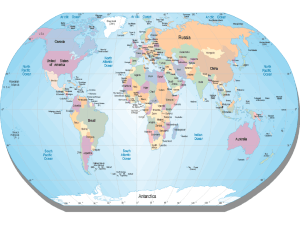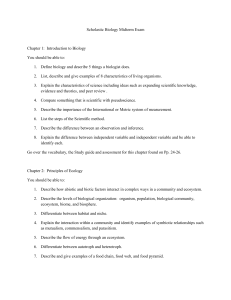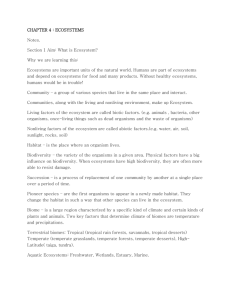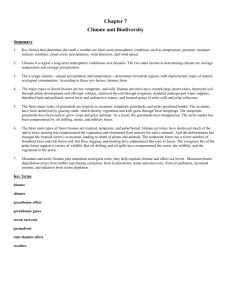Chapter 54
advertisement
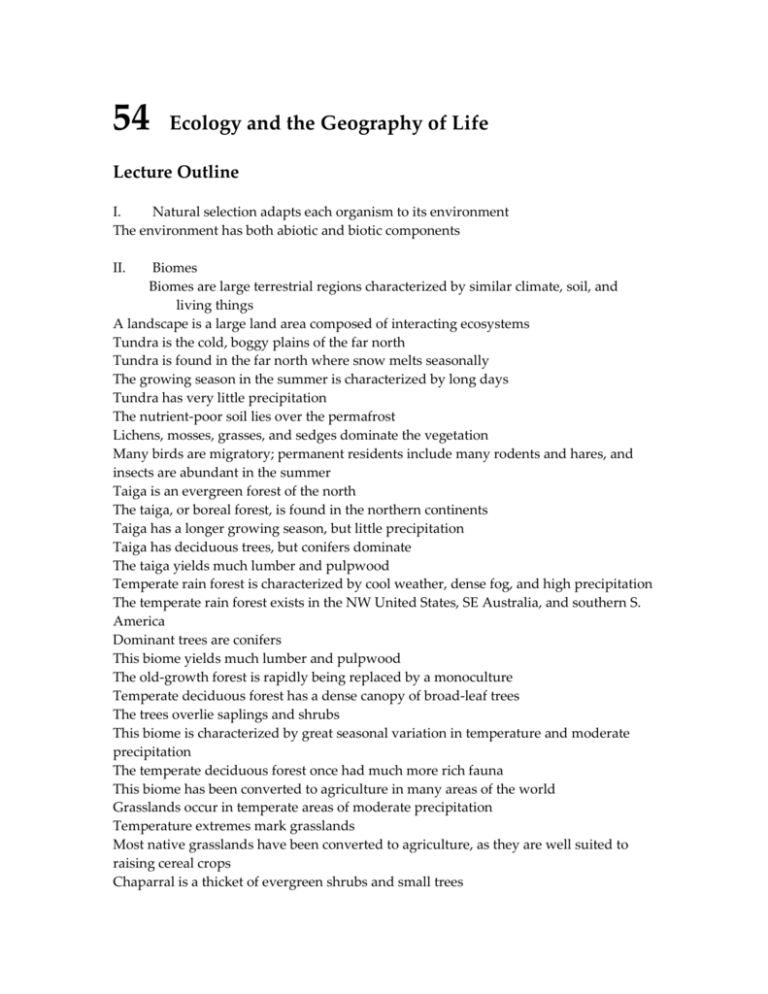
54 Ecology and the Geography of Life Lecture Outline I. Natural selection adapts each organism to its environment The environment has both abiotic and biotic components II. Biomes Biomes are large terrestrial regions characterized by similar climate, soil, and living things A landscape is a large land area composed of interacting ecosystems Tundra is the cold, boggy plains of the far north Tundra is found in the far north where snow melts seasonally The growing season in the summer is characterized by long days Tundra has very little precipitation The nutrient-poor soil lies over the permafrost Lichens, mosses, grasses, and sedges dominate the vegetation Many birds are migratory; permanent residents include many rodents and hares, and insects are abundant in the summer Taiga is an evergreen forest of the north The taiga, or boreal forest, is found in the northern continents Taiga has a longer growing season, but little precipitation Taiga has deciduous trees, but conifers dominate The taiga yields much lumber and pulpwood Temperate rain forest is characterized by cool weather, dense fog, and high precipitation The temperate rain forest exists in the NW United States, SE Australia, and southern S. America Dominant trees are conifers This biome yields much lumber and pulpwood The old-growth forest is rapidly being replaced by a monoculture Temperate deciduous forest has a dense canopy of broad-leaf trees The trees overlie saplings and shrubs This biome is characterized by great seasonal variation in temperature and moderate precipitation The temperate deciduous forest once had much more rich fauna This biome has been converted to agriculture in many areas of the world Grasslands occur in temperate areas of moderate precipitation Temperature extremes mark grasslands Most native grasslands have been converted to agriculture, as they are well suited to raising cereal crops Chaparral is a thicket of evergreen shrubs and small trees Chaparral occurs in California, Western Australia, Chile, South Africa and the Mediterranean area Chaparral is dominated by drought-resistant shrubs and scrub and is adapted to fire Deserts are arid ecosystems Deserts are dry areas found in temperate (cold deserts) and subtropical or tropical regions (warm deserts) Low precipitation results in sparse vegetation Desert plants often exhibit allelopathy Desert plants tend to be small and often aestivate during periods of drought Savanna is a tropical grassland with scattered trees Savanna is found in Africa, S. America, W. India, and N. Australia The greatest abundance of hoofed mammals occurs in the savanna Savanna is often converted to rangeland for domesticated animals There are two types of forests in tropical areas Tropical dry forests have both a wet and dry season Tropical rain forests are lush equatorial forests Tropical rain forests are characterized by high precipitation and high temperatures The soils in this biome are old and have little organic matter The tropical rain forest is unrivaled in plant and animal diversity The plant community is characterized by layers, many epiphytes, and lianas (woody vines) This biome is threatened by overpopulation of indigenous people and exploitation of resources by developed countries III. Aquatic ecosystems occupy most of the Earth’s surface A. Aquatic is classified primarily on abiotic factors but also on types of organisms Aquatic ecosystems vary in temperature, salinity, dissolved oxygen, and current There are three ecological categories of organisms Plankton are organisms that are at the mercy of currents and waves Phytoplankton are the photosynthetic organisms Zooplankton are heterotrophic protozoans and animals Nekton includes organisms that swim more strongly Benthic organisms live on or in the bottom Freshwater ecosystems are closely linked to land and marine ecosystems Freshwater ecosystems include flowing-water ecosystems, standing-water ecosystems, and wetlands These bodies of water make up a small portion of the earth’s surface, but are ecologically important and may moderate temperatures of adjacent terrestrial ecosystems Rivers and smaller streams are flowing-water ecosystems Headwater streams are typically shallow, fast-flowing, and highly oxygenated Headwater streams are dependent on detritus as a primary energy input Rivers are typically deeper, slower flowing, and have less dissolved oxygen Organisms found in the different flowing water habitats are adapted to these characteristics Ponds and lakes are standing-water ecosystems Lakes of a substantial size can be divided into the littoral, limnetic, and profundal zones The littoral zone is the shallow zone surrounding the lake and may have emergent and nonemergent plants Phytoplankton are the base of the food chain in the limnetic zone The profundal zone is below the depth of light penetration Thermal stratification occurs in temperate lakes Large temperate lakes stratify in both the summer and winter The thermocline is the zone of rapid temperature change The fall and spring turnovers are the times of mixing Increased nutrients, stimulated by human activities, stimulate algal growth Enrichment caused by human actions leads to eutrophication Freshwater wetlands are transitional between aquatic and terrestrial ecosystems Freshwater wetlands include hardwood bottomland forests, prairie potholes, and peat bogs Wetlands are important in flood control, breeding sites for birds, and recharge of groundwater; these are called ecosystem services Estuaries occur where fresh water and saltwater meet Temperate estuaries typically encompass salt marshes dominated by grasses and sedges Estuaries undergo marked changes in temperature, salinity, and other physical characteristics Salt marshes are very productive, and are important breeding sites for fish Mangrove forests dominate in tropical areas and are also important breeding sites for fish Estuaries and other coastal areas are threatened by population growth and economic development Two-thirds of the world's population lives within 150 km of a coastline, and therefore these areas are impacted by our activities Marine ecosystems dominate Earth’s surface The intertidal zone is transitional between land and ocean The intertidal zone is the area between the low and high tides This highly productive zone is also a very stressful habitat Sandy intertidal zones are characterized by shifting sand Rocky intertidal zones provide anchorage for algae and animals Animals and plants have adaptations to avoid desiccation Seagrass beds, kelp forests, and coral reefs are part of the benthic environment The benthic environment is the ocean floor The abyssal zone extends from a depth of 4000 to 6000 meters The hadal zone is greater than 6000 meters Seagrasses are flowering plants adapted to being submerged Kelps are the largest brown algae; they are the primary photosynthesizers in kelp forests and also provide habitats for marine animals Coral reefs are very productive benthic habitats, and are restricted to shallow depths as the coral require zooxanthellae Fringing reefs surround an island The barrier reef is widely separated from the island An atoll is a circular reef surrounding a lagoon, and is the final stage of reef development The neritic province consists of shallow waters close to shore The neritic province is the area of open ocean lying over depths up to 200 m The euphotic region is the lit zone where photosynthesis occurs Zooplankton eat phytoplankton, and nektonic organisms eat zooplankton The oceanic province comprises most of the ocean The oceanic province is characterized by depths greater than 200 meters Marine snow is organic debris that "rains" down into the euphotic region Overfishing is a threat to the neritic and oceanic provinces Many commercially important fishes have reached commercial extinction due to over fishing The Georges Bank, off the coast of New England, was once a very important fishery, but now has a fishing moratorium due to overfishing IV. V. Ecotones B. All biomes and ecosystems interact in ecotones Biogeography C. Biogeography is the study of geographical distribution of plants and animals Biogeographers search for patterns in geographical distribution and try to explain how such patterns arose A basic tenet of biogeography is that each species arose only once The place where this occurred is known as the species' center of origin The range of a particular species is that portion of the Earth on which it is found Localized, native species are said to be endemic Species having a worldwide distribution are cosmopolitan Land areas are divided into six biogeographical realms The Neartic and Paleartic realms are more closely related than the other regions The Neotropical realm was almost completely isolated from the Neartic realm and other land masses for most of the last 70 million years The Ethiopian realm contains the most varied vertebrates of all six realms The Australian realm has not had a land connection with the other realms for more than 85 million years and is dominated by marsupials and monotremes Research and Discussion Topics Which biomes or oceanic zones are characterized by the highest diversity? Lowest diversity? Highest and lowest biomass? What animal groups are restricted in their distribution in biomes and zones? More importantly, why are they restricted to these zones? Critically analyze plant communities with respect to the previous questions. Are the answers the same or different? Why?

